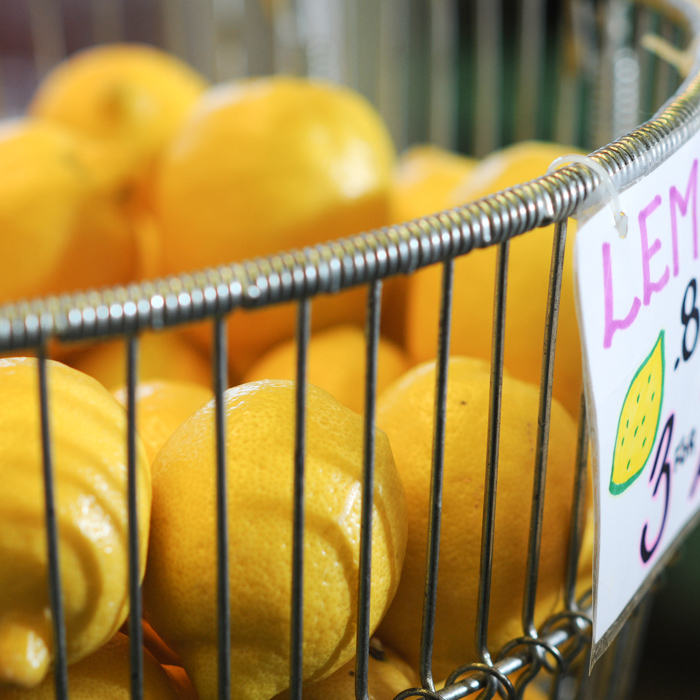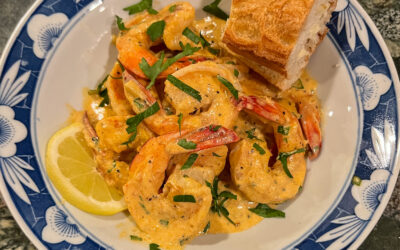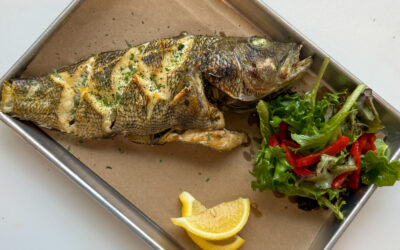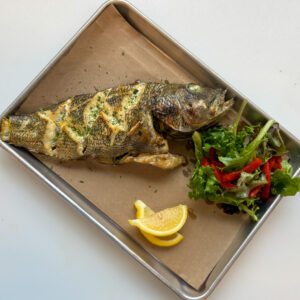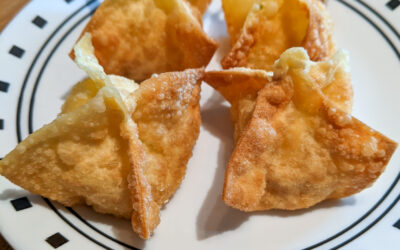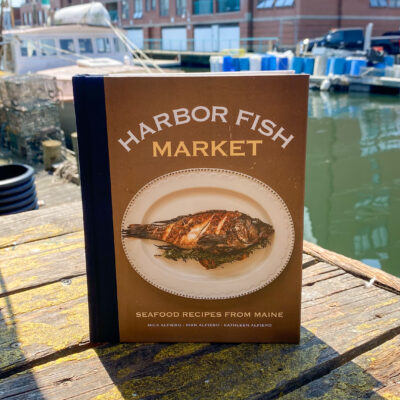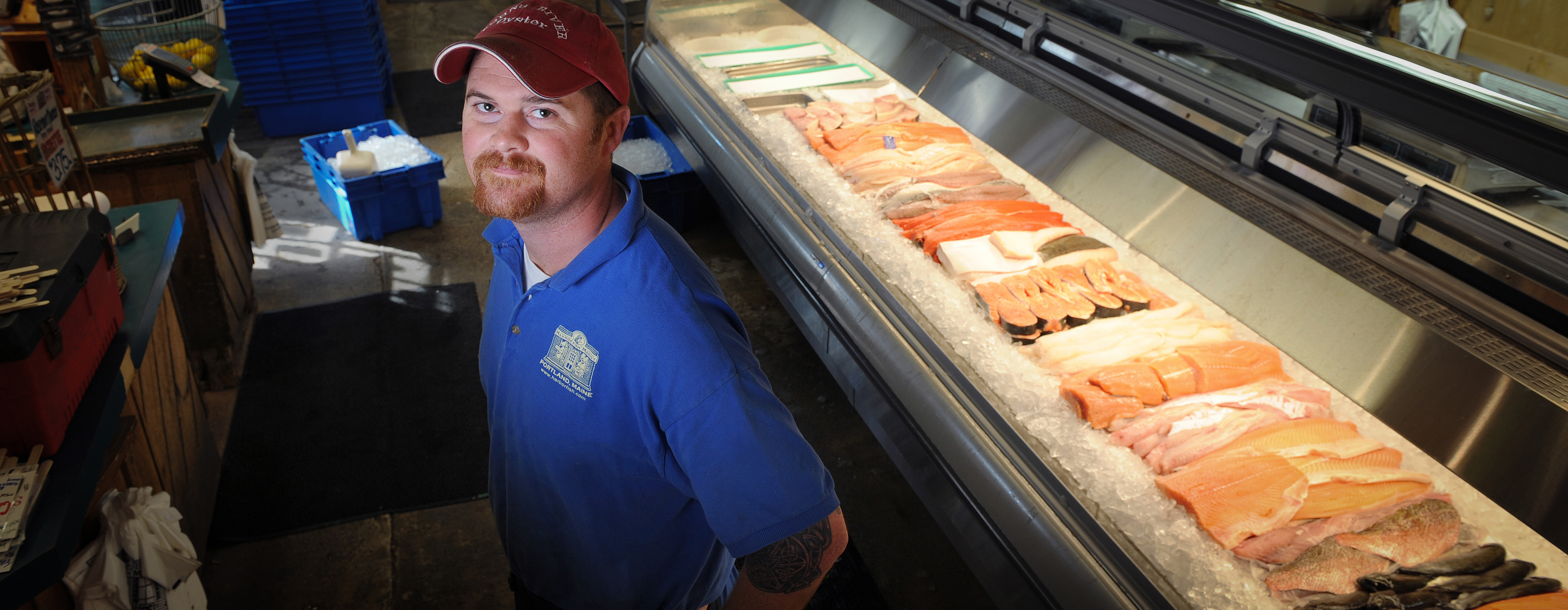
[ultimate-recipe-index]
Spicy Ecuadorian Shrimp Lo Mein
Spicy Ecuadorian Shrimp Lo Mein
Ingredients
- 1 lb fresh Ecuadorian Shrimp, peeled & deveined
- 2 tbsp. canola oil for frying
Marinade
- 1 tsp corn starch
- 1 tbsp Shaoxing Rice Wine
- 2 tsp light soy sauce
Stir Fry Sauce
- 1/3 cup Shaoxing Rice Wine
- 1/4 cup oyster sauce
- 4 large cloves garlic, pressed
- 1 1/2 tbsp grated ginger
- 2 tbsp. dark soy sauce
- 1 tsp brown sugar
- 1-2 tbsp chili garlic sauce (use more or less depending on heat tolerance)
- 1 tbsp chili crisp (optional)
Stir Fry & Noodles
- 8 ounces lo mein noodles, fresh if possible, you can also use a thicker spaghetti cooked al dente
- 1 red pepper sliced thinly
- 1 small container mushrooms thinly sliced
- a couple handfuls of snow peas
- ½ carrot shredded
- 1 bunch scallions sliced
Instructions
- Remove tails from shrimp if you wish or leave them on for extra flavor. Mix the marinade ingredients in a bowl, add the shrimp and marinate for at least 20 minutes.
- Instructions for preparing the lo mein noodles will be on the package. Be sure to have the noodles prepared and cold drained when you start to stir fry.
- Prepare stir fry sauce in a 1-2 cup measuring cup. Mix well. Taste it and adjust the heat level to your preference. Set aside.
- Heat the oil in a wok over medium heat. Wait till pan shimmers before adding shrimp. Cook for a minute, then turn the shrimp over using chopsticks or tongs. When the shrimp have barely turned pink, remove and set aside.
- Add all the vegetables except scallions to the wok and turn the heat up a little. Depending on the cook you like of the vegetables you can add mushrooms first, then peppers and lastly snowpeas.
- When the vegetables are nearly cooked, return the shrimp to the wok, cook for a minute or two to cook through. Add the well mixed stir fry sauce. Stir and add the noodles. Tongs are useful at this point to spread noodles out and incorporate them into the vegetables and sauce. Toss in scallions, stir and serve.
Notes
Salt Baked Branzino
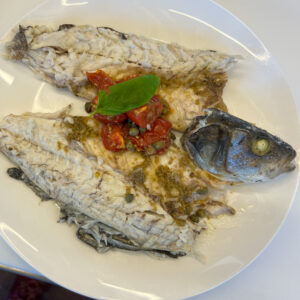
Salt Baked Branzino
Ingredients
- 2 whole branzino cleaned, fins removed (about 1 lb each)
- 1/2-3/4 cups Extra-virgin olive oil more for drizzle
- 1 tsp freshly chopped tarragon
- 1 tsp freshly chopped oregano
- pepper to taste
- 2 lemons one for the juice, one for thin slices, extra if you want to add wedges at the end
- 6-8 branches fresh herbs such as thyme, rosemary, sage or a store bought "poultry bouquet"
- 4 tbsp green olive tapenade or spread or finely chopped green olives
- 6-8 cherry tomatoes halved
- capers to taste optional
- 8 cups Diamond Crystal kosher salt more if needed
- 1/2 cup water to start
Instructions
- Heat oven to 400 degrees. Line a rimmed sheet pan with parchment paper.
- Blot the fish dry with a paper towel. Mix the tarragon, oregano, pepper and lemon juice into the olive oil. Brush both sides and the cavities of the branzino with the olive oil mix.
- Spread the tapenade into the cavities.
- Place the lemon slices, tomato halves, capers and fresh herbs inside the fish. Be sure not to overstuff the fish, you will want the cavity to remain closed.
- In a large bowl, stir the salt with ½ cup cold water, adding more water as needed. You want the salt to feel like damp (not wet) sand. You should almost be able to mold it.
- Create a salt bed for your fish on the parchment lined sheet pan. Scoop about half the salt onto the baking sheet and pat it into an even ½-inch-thick bed (or 2 separate beds) on which to lay the fish. Place the fish on top and use your hands to pat the remaining salt all around the fish so everything is enclosed and sealed. You may need to make more of the salt mixture. The goal is to have a thick crust that completely encloses the fish so it can steam inside. You can leave the tail sticking out as you won't be eating it.
- Find the thickest part of the fish, usually the nape and use an instant read thermometer to poke a hole through the salt crust to touch the top of the fish. This is so you can take its temperature without cracking the crust. You are not keeping the thermometer in, just creating a hole.
- Bake for 25-35 minutes. The fish is done when its internal temperature reaches 135 degrees (use the hole you made to insert the thermometer to check). If you do not have a thermometer use the 35 minutes to bake. It's hard to overbake the fish due to the encasement of salt. Take fish out of the oven and let rest for 5 to 10 minutes.
- Using a butter knife or metal spoon, crack open the crust, removing it entirely from the top of the fish and discard salt. Gently place fish on another clean pan (minus the salt). Then peel off and discard the skin on top (it’s too salty to eat). Using a spoon or spatula, carefully remove the fish flesh from the bones (and poke out fish cheeks if you like). Lift the fish skeleton, remove lemons and herbs, you can keep the tapenade, capers and tomatoes. Scoop out bottom fillets, taking care not to puncture the skin which you will remove before serving.
- Drizzle fish fillets with olive oil, if you like, and serve with lemon wedges.
Notes
Chris’ Maple Baked Haddock

Chris' Maple Baked Haddock
Ingredients
- 1 lb haddock
- 1 cup sour cream
- 2 tbsp pure maple syrup less or more to taste
- 1 tsp lemon juice
- 4 tbsp bread crumbs
- 1/4 tsp paprika
Instructions
- Preheat oven to 425
- Butter the bottom of casserole dish, place fish in the dish.
- Mix remaining ingredients together in a bowl.
- Spread on top of the fish.
- Bake for 35 minutes. Enjoy!
Dublin Lawyer (Shrimp or Lobster with Irish Whiskey and Cream)
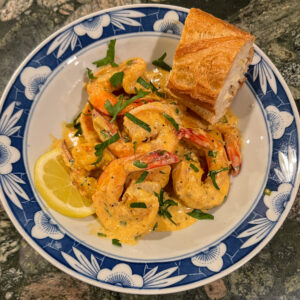
Dublin Lawyer (Shrimp or Lobster in Irish Whiskey and Cream)
Ingredients
- 1 lb shrimp peeled and deveined or lobster meat
- 4 tbsp unsalted Irish butter
- 2 tbsp shallots finely chopped
- 2 cloves garlic minced
- 2 tsp paprika
- Dash of cayenne pepper or a bit more if you like a kick
- freshly ground black pepper
- 1 tsp salt (or to taste)
- 1/2 cup Irish whiskey
- 1 ½ cups heavy cream
- 1-2 tsp fresh lemon juice
- 2 tbsp chopped parsley plus a little for garnish
Instructions
- If you are using lobster, chop meat into bite sized pieces.
- In a large saucepan over medium-high heat, melt butter. Add shallots and garlic. After 2-3 minutes, add lobster or shrimp and season with salt, pepper, cayenne and paprika.
- Saute the shrimp for around 3-4 minutes or until cooked. (If using already cooked lobster meat just warm through.) Remove seafood from pan and reserve on a plate.
- Slowly add whiskey to pan. Light the whiskey (use a long match or fire starter) and allow the alcohol to burn off. This should take just a few minutes. BE VERY CAREFUL - WHISKEY BURNS HIGH
- Add cream and simmer for 3-5 minutes or until starts to thicken. Add lemon juice and parsley. Add seafood back into saucepan and toss to coat and warm.
- Top with a sprinkling of parsley.
Notes
Paddy’s Irish Fish Chowder
Paddy's Irish Fish Chowder
Ingredients
- 3 tbsp Irish butter
- 1 cup leeks finely chopped
- 1 cup celery finely chopped
- 1 cup carrot finely chopped
- 2 cups fish stock or chicken broth
- 3/4 cups Guinness Stout
- 1 tsp thyme
- 2 bay leaves
- 1 tsp paprika
- 1 tsp dill
- dash of cayenne optional
- salt and pepper to taste
- 1 lb haddock hake or cod, cut into chunks
- 2-4 oz finnan haddie or smoked shrimp or scallops depending on how smoky you'd like it
- 3 medium potatoes peeled and diced
- 2 ½ cups milk
- 1 cup cream or half and half
- 1 tbsp fresh parsley finely chopped
Instructions
- In a Dutch oven or large pot with a lid, melt the butter. Add onion, celery and carrot and sauté for about 5 minutes.
- Add the stock, Guinness and potatoes and bring to a boil. Reduce the heat, cover and simmer for about 10 minutes or until potatoes are tender. Add the milk, thyme, bay leaf, dill, cayenne, salt and pepper to stock pot and bring to a simmer. Cook for about 5 minutes, stirring frequently. Add the fish and smoked seafood and simmer stirring frequently taking care not to break up the fish for about 5 minutes or until the fish is cooked. Stir in the cream and heat for for about a minute or two until warmed. Garnish with parsley and paprika.
Notes
Whole Roasted Fish
Whole Roasted Fish
Ingredients
- 1 whole fish, 1 - 1/2 lbs, Black Sea bass, branzino, hybrid striped bass, red snapper
- 2 tbsp olive oil
- 1 lemon
- 2 sprigs rosemary or fresh herb of your choice
- salt & pepper to taste
Instructions
- Preheat oven the oven to 450 degrees
- Score the fish (three shallow, short cut marks on each side). Rub the cleaned whole fish and the baking sheet or dish you are using with the olive oil. Place the lemon slices and herbs into the score lines and the fish cavity and salt and pepper the entire fish along with the cavity and scores.
- Place the fish in the hot oven for approximately 20 minutes. Test for doneness by lifting the flesh up from the bones by the dorsal fin. If the meat is opaque and not translucent, then it is ready to serve.
- With a wide spatula, lift the entire fish off the pan onto a plate and serve as is. If you prefer, peel the skin off the upper side. Lift the meat off the bones with a cake spatula and put on a plate. Remove center bones and heel by lifting and discarding. Lift the bottom fillet onto the plate as well.
- Enjoy!
Notes
Employee recipe! Alex C.’s Shrimp Rangoon

Employee recipe! Alex C.'s Shrimp Rangoon
Ingredients
- 1 package square wonton wrappers usually frozen and will need to be thawed
- 1 pound peeled deveined raw shrimp 26/30 size
- 16 oz cream cheese softened
- 1 bunch scallions
- 1 tbsp butter
- 1.5 tbsp Old Bay seasoning
- Couple dashes of Salt pepper garlic seasoning
- Kosher salt
- Hot sauce Mild like Cholula, or whatever you prefer
- Olive oil
- Frying oil peanut oil or vegetable oil
- 2 ~ tbsp Cornstarch
Instructions
- Pull tails off the shrimp if needed and cut them into small pieces. About 5-6 pieces per shrimp, set aside and sprinkle with a couple pinches of kosher salt.
- Cut cream cheese blocks into even pieces to help it soften and will be easier to mix later.
- Slice scallions into even pieces.
- In a large skillet, add a couple glugs of olive oil, add the butter over medium heat. Add shrimp and cook stirring frequently to cook all shrimp evenly.
- When the shrimp no longer have the raw look to them, remove from heat and place in a large mixing bowl along with some of the oil and melted butter in the skillet.
- Add cream cheese, scallions, SPG seasoning, Old Bay and a few dashes of hot sauce to the mixing bowl along with shrimp. The heat from the shrimp will help to soften the cream cheese more.
- Stir carefully to make a smooth cheesy mixture.
- In a high walled pot add around 1.5 inches of oil and heat to 375° F.
- In a small bowl or ramekin, add a cup or so of water along with the cornstarch and stir.
- As the oil heats, start assembling the rangoons. With wontons, rangoon mix and cornstarch slurry at hand, add a small to medium size dollop of mix to the center of a wonton. Dip 2 fingertips into cornstarch and coat the edges of the wonton in the cornstarch slurry. Bring two opposite corners together and pinch press them together then the other corners and pinch them all together. While trying to remove most of the air, pinch each of the four new corners and seams until it is all sealed and set aside on a plate. (This can take some practice and there are a variety of shapes you can make your rangoons into)
- Once you’ve assembled 6-8, carefully place into the hot oil and fry until the corner edges are nicely browned. Remove them from oil with a spider strainer (or tongs, just be careful not to drop them) set aside to cool a bit on a wire rack in a baking sheet.
- Working in batches, assembling more as others fry, this recipe can make around 56 rangoons.
Notes
Mike A.’s Ginger Soy (GF) Marinade
Mike A.'s Soy Ginger (GF) Marinade
Ingredients
- 1/2 cup low sodium Tamari
- 2 tbsp toasted sesame oil
- 2 tbsp brown sugar you can use less
- 1 scallion chopped
- 2 tbsp grated fresh ginger more or less to taste
- 2 large garlic cloves finely chopped, more or less to taste
- fresh lime juice to taste, up to 1 lime
- 1 tsp sriracha or red pepper paste or your choice optional
Instructions
- Combine all ingredients. Mix well.
- Marinate fish no more than 1/2 hour.
- Store in refrigerator up to 1 week.
Notes
Laura V.’s Cod Cakes

Employee Recipe! Laura V.'s Cod Cakes
Ingredients
For the Cod Cakes
- ½ cup milk
- 1 bay leaf
- 1 pound cod cut into 1-inch pieces
- salt and freshly ground black pepper to taste
- 12 ounces russet potato peeled and quartered
- 1 pinch cayenne pepper
- 1 tbsp finely chopped Italian parsley
- 1 tbsp sliced fresh chives
- 1 tsp finely grated lime zest
For the Tartar Sauce
- ½ cup mayonnaise
- 2 tbsp capers drained and chopped
- 1 tbsp finely chopped shallots
- 1 tbsp finely chopped Italian parsley
- 2 tsp prepared horseradish
- 1 tsp Stone ground mustard
- 1 pinch cayenne pepper
For the Breading
- ⅓ cup all-purpose flour
- 1 large egg beaten
- 1 cup panko bread crumbs or as needed
- ¼ cup vegetable oil or as needed
Instructions
- Mix mayonnaise, capers, shallot, parsley, horseradish, mustard, and cayenne together in a bowl for tartar sauce and refrigerate until needed.
- Add milk and bay leaf to a saucepan and place the pieces of fish over the top. Season with salt. Bring to a simmer over medium heat, and cook for about 2 minutes, stirring occasionally. As soon as the fish firms up, but before it starts to flake apart, turn off the heat and cover. Let sit for 5 minutes before draining. Let cool, about 10 minutes. Refrigerate until needed.
- Meanwhile, bring a pot of lightly salted water to a boil. Add russet potato and boil until tender but not falling apart.
- Drain and mash potato in a bowl. Season with salt, black pepper, and cayenne. Add parsley, chives, and lime zest; add 1 tablespoon tartar sauce mixture. Mix until combined.
- Flake chilled fish over the top. Mix until combined.
- Scoop out ¼ of the mixture and form into a patty. Repeat with remaining mixture.
- Dust cakes with flour on both sides. Brush both sides of cakes with beaten egg. Coat in bread crumbs.
- Heat oil in a skillet over medium heat. Pan-fry patties in the hot oil until golden brown and heated through, 3 to 4 minutes per side.
- Heat oil in a skillet over medium heat. Pan-fry patties in the hot oil until golden brown and heated through, 3 to 4 minutes per side.
- Serve with tartar sauce and enjoy!
Notes
Of course, these are just a few. Our very best recipes, from our family and our entire community, can be found in our cookbook!
How many lobsters do I need?
What is the difference between a hard shell lobster and a soft shell lobster?
How long can I keep my lobsters before cooking them?
How do I store my lobsters before I am ready to cook them?
My lobster has only one claw, and there is an unattached claw in the bag, what happened?
Will you cook my lobsters for me?
How should I cook my lobster?
What tools do I need to eat lobster?
What is the green stuff in my lobster?
What is the bright red waxy stuff in my lobster?
How many lobsters do I need?
Of course this depends on a lot of factors. Just as a guideline, you could serve two small (1 lb.) or medium (1¼ lb.) lobsters per adult as a main course. You could serve one large (1½ lb. or larger) lobster as a main course. Or skip the sides and dessert, and add a lobster!
What is the difference between a hard shell lobster and a soft shell lobster?
A soft shell lobster is a lobster that has, as a normal function of its growth, shed its shell. This tends to happen sometime in early- to mid-summer. Most soft shell lobsters have typically become hard shell by November or December. During this period, known as soft shell season, hard shell lobsters are still available (though less plentiful). Soft shell lobsters generally contain less meat per pound than hard shells, though that meat is a bit sweeter and more tender. Soft shells are not recommended for travel, nor can we ship them, as their life expectancy is a much shorter out of water.
How long can I keep my lobsters before cooking them?
It’s always best to get your live lobsters the same day they are going to be cooked. Once out of water, hard shell lobsters have a life expectancy of 24 to 36 hours, and soft shells can live anywhere from 2 to 12 hours. Obviously, these are estimates, not guarantees.
How do I store my lobsters before I am ready to cook them?
The important factor in keeping live lobsters is temperature. We recommend that the lobster be stored in the crisper drawer of your refrigerator. If your lobster was shipped, or packed to travel, you can use some of the seaweed in your package to cushion and cover the lobsters. Optionally, you can add a small damp cotton towel to the drawer to keep the environment moist (not drenched). Under no circumstances should you place the lobsters in standing water of any kind.
My lobster has only one claw, and there is an unattached claw in the bag, what happened?
As a defense mechanism, Lobsters can release or throw their claws (and also grow them back). Most likely, the lobster dropped its claw in transit. You may cook and eat the claw (make sure it has not spoiled) as though it were still attached.
Will you cook my lobsters for me?
Yes, we will happily steam your lobsters for you, at a small additional charge (for orders of a typical quantity). In store, last call for hot pick-up is 5:00 PM. We can also half-cook your lobsters, which will cut down your cooking time and allow you to serve them hot.
The most common preparation is to simply steam the lobsters. You’ll find instructions here in our recipe section.
What tools do I need to eat lobster?
At the very least, you’ll need some heavy-duty nutcrackers. We also use specialized tools to get at the meat once the shell is open. We also recommend keeping a mug of broth nearby so you can give the meat a quick rinse before you dunk it in butter or vinegar. You’ll find everything you need in our shop.
What is the green stuff in my lobster?
That is the tomalley, or liver of the lobster, and it’s delicious. If you are not a connoisseur of tomalley, simply rinse it off.
What is the bright red waxy stuff in my lobster?
You have a female lobster that is starting to form eggs (or roe). They are edible and, like the tomalley, are considered a delicacy. If you are not interested in eating them, you can remove them with your fork or simply rinse them away.
Is the fish I’m buying at HFM fresh?
How much fish do I need?
Will there be bones in my fish?
What does PBO mean?
What is scrod?
Does lemon sole taste like lemon?
What’s a good fish for a chowder?
Is there a whitefish that is great for grilling?
What is the difference between steaks and fillets?
Can I freeze my fish?
What does F.R. stand for?
I am never certain how to cook my fish, do you have any suggestions?
What is HACCP?
Is the fish I’m buying at HFM fresh?
When we say it is fresh we mean it, and if it has been frozen we will always identify it as such. We’ve worked hard to gain the trust of our customers, and we’ll never take advantage of it.
How much fish do I need?
Of course, the answer to this depends on the person eating, but we typically recommend about an 8-ounce portion per person.
Will there be bones in my fish?
This depends on the fish you are buying. It’s always a good idea to check any fillet for bones, even ours. We do inspect each fillet thoroughly, but we are only human. Some fillets are cut so that bones are included. The nape and first 3 to 4 inches on most fillets is where you will find bones. Some fish do have pin bones that run down the center of the fillet, and these can be easily removed with tweezers.
What does PBO mean?
PBO is a term that means “pin bones out,” commonly used when talking about salmon fillets. If you catch a fish yourself and fillet it you will find a pair of tweezers useful at getting these bones out without destroying the fillet.
What is scrod?
Scrod is a word that has had many meanings. At Harbor Fish, it simply refers to a smaller fish, usually only used in reference to haddock or cod.
Does lemon sole taste like lemon?
No, it’s simply a name for a particular species of flatfish (Microstomus kitt), like Grey Sole or Dover Sole. In fact, it’s a misnomer, as Lemon Sole is technically not a sole! It’s similiar enough to sole, however, that the name is there to stay.
What’s a good fish for a chowder?
Many fish make an excellent chowder but if you are looking for a fish that doesn’t fall apart and has that mild sweet white fish flavor you should probably try Cusk. Cusk meat has a simliar consistency to a lobster tail, but with a flavor more like haddock or cod.
Is there a whitefish that’s great for grilling?
Yes! Hake is a very good candidate, cusk is another, as are halibut steaks or fillets. There are others, but these species are often more available.
What is the difference between steaks and fillets?
Steaks are made when we cut a whole fish horizontally, creating sections along the fish, bones and all. A fillet is made when we cut the fish from the head to the tail and remove the meat in one long piece.
Can I freeze my fish?
Yes, indeed. All of our fish is fresh, all natural, with no chemicals added, unless specified. If you order a previously frozen product from us, we wouldn’t recommend freezing it again.More storage information.
What does “FR” stand for?
“FR” indicates a fish that was farm-raised, please see our TKTKTK Product Origination information sheet in the recipe section of our web site for further information on farmed-raised fish.
I am never certain how to cook my fish, do you have any suggestions?
Yes we do, we regularly post excellent recipes here on our web site, which will get added to as we grow the site, but for good basic information see ourcooking tips for fish and seafood. You can also purchase our LINK TKcookbook on our online store..
What is HACCP?
Hazard Analysis Critical Control Point is the FDA’s system for preventative food safety, which we follow carefully. For more from the FDA: Here you can define the content that will be placed within the current tab.
What time will my shipment arrive?
Can I get my lobsters delivered on a Saturday?
What if I can’t be there to sign for my package?
Who has to be there to sign for the package?
What if I want to cancel my order?
How soon should I place my order?
Do my Lobsters arrive alive?
How do I pay for my lobster shipment?
How are my lobsters packaged?
What if my package doesn’t arrive in time?
What information will you need from me to place an order?
What time will my shipment arrive?
We ship our fresh seafood using FedEx Priority Overnight service. Most deliveries take place between 8:30 AM & Noon, though in some more remote areas it could be as late as 4:30 PM. You’ll receive tracking information when your order ships.
Can I get my lobsters delivered on a Saturday?
Saturday delivery is available for most customers but not all (typically it’s not available in more remote areas. Please check your address with FedEx to find out if Saturday delivery is available for you). Please note that FedEx places a surcharge on Saturday delivery. If you don’t live in an area that is in a Saturday zone you might be able to go to your nearby FedEx station and pick them up.
What if I can’t be there to sign for my package?
By default, we require a signature on all fresh seafood deliveries. If you would like us to release the FedEx signature requirement for your order, please call us at +1 (207) 775-0251 x 2 to make arrangements. Obviously, having a package left outside your door opens you up to the risk of theft. Also, even with our careful, insulated packaging, we never recommend leaving a package of fresh seafood exposed to the elements. If you release signature, you have no recourse with Harbor Fish Market or FedEx in the case of loss.
Who has to be there to sign for the package?
Anyone answering the door at the delivery address can sign for the delivery as long as they are 18 years of age or older.
What if I want to cancel my order?
Order cancellations must be made at least 24 hours before the shipping date. Please contact the shipping department at +1 (207) 775-0251 x 2.
How soon should I place my order?
We encourage advanced ordering. You can choose a specific delivery date during the order checkout process in our online shop. This allows us to plan our supply and staffing, which is important in the seafood industry, where so much changes from day to day. If you wish to place an order for a date further out than allowed by our online system, please feel free to call us at +1 (207) 775-0251 x 2.
Do my Lobsters arrive alive?
We cannot guarantee the life span of a lobster. However, our hearty hard shell lobsters tend to live an average of 24 to 36 hours out of water, and we always pack lively lobsters for shipment (we want you to have a nice dinner, too!). In the rare case a hard shell lobster dies while in transit, you can still cook and eat it within 12 hours of death, as long as it has been kept refrigerated (Lobsters are kept sufficiently cold in our insulated packaging under normal conditions). We enclose a shipment instruction sheet that will give you more information on how to determine if a lobster has spoiled. It is very rare that a lobster we ship you is not edible.
How do I pay for my lobster shipment?
We accept Visa, MasterCard, American Express and Discover. You can also use a Harbor Fish Market Gift Card.
How are my lobsters packaged?
Your lobsters are packed in expanded polystyrene foam coolers (which don’t contain any ozone-depleting CFC’s), with a corrugated printed box around it. We use gel ice unit(s) and seaweed to maintain temperature and moisture. Please note that during certain periods in the spring, seaweed is spawning and may not be suitable for use. Also, during winter storms, it may become too hazardous to harvest the seaweed.
What if my package doesn’t arrive in time?
We make every effort to contact you ahead of time and reschedule your shipment if we are able to anticipate weather events that will affect your order. Despite our best efforts, sometimes packages don’t arrive as ordered, due to unforeseen circumstances. If the package doesn’t make it to you on time due to an act of God (the most common one being weather), we cannot refund your purchase, nor is there any insurance recourse with FedEx. The shipping of perishables is at the risk of the purchaser. If your package doesn’t arrive due to human error, you would then receive a full refund from Federal Express. In that case, we will place all the necessary paperwork for you and credit your account in full upon receiving reimbursement from Federal Express. Federal Express has the last word in determining the outcome of any claim.
What information will you need from me to place an order?
We will ask you for the recipient’s name, complete street address (no PO boxes), zip code, phone number, your payment information, and product request. It is never a good idea to surprise someone with a gift of live lobsters, as they do need to be cooked the day they are received. We find a gift card works best in this situation allowing your recipient to be surprised by your thoughtfulness but also have the chance to plan their mouthwatering feast.
Additionally, your information is never sold to or used by any other company or group, and your payment information is not stored with us, so even our employees don’t have access to your credit card information.
How do you prepare the Maine steamer clam?
How long can I keep my seafood before eating it?
What does this type of oyster taste like?
How do you shuck an oyster?
What is meant by “dry,” or “all natural” scallops?
How do you prepare the Maine steamer clam?
Unfortunately, you will never get all the sand out of the Clam. The best way we have found is to place them in your sink, take the spray hose to the outside of the shell using cold water. After you have washed the outside as best you can, fill the sink up with enough cold water to completely cover the clams. Depending on how many steamer you have add a good dose of white vinegar (or red) and occasionally gently swish them around. Let them sit in the sink for about a half hour. This will make them spit up anything in there intestinal track. Drain and spray rinse one more time. Then after cooking them, make sure you serve broth to vigorously dunk them up and down in, to wash off any grit that still may remain.
How long can I keep my seafood before eating it?
Most seafood—if stored in proper conditions—can be held for a couple of days, depending upon the harvest date. This is where it helps to have a good relationship with your seafood dealer, to be sure of the freshness of your fish!
There are several factors that go into the storing of each type of seafood. In general, the best way to keep most seafood is buried in ice with the melt water drained off. If we’re trying to keep fish fresh at home, we typically put the plastic-wrapped (watertight) package in a bowl of ice in the fridge. If we are trying to keep shellfish (such as mussels, clams, oysters, or hard-shell clams) we’ll ring out a wet towel and place it over a bowl containing the shellfish, and put the bowl either in the fridge or packed into a cooler, sitting on a bed of ice. The most important factor is a cold temperature, but it’s also important not to allow the shellfish to sit in fresh water. It also seems to help to allow a bit of airflow around the shellfish, so don’t pack mussels or clams, etc. in airtight plastic.
What does this type of oyster taste like?
We have compiled a list of the types of oyster that we carry from time to time. Please understand that taste is hard to explain and we suggest you make notes for yourself when having a different type of oyster as to what it tasted like to you. (Click here for taste description)
How do you shuck an oyster?
First and most important buy an oyster shucking knife. We have heard of more people using every utensil known, other then the knife designed for the job. Not that using an oyster Knife will keep you from getting injured, its just that it will do a better job then most other instruments, as it was designed with an oyster shell in mind.
- Step 1: In the hand that is holding the oyster, drape a towel or put on an oven mitt. Hold the oyster firmly in that hand, the knife in the other. Slip the knife blade between the top and bottom shell right by the hinge on the back. Be aware that the ridges on the shell are very sharp and can cause harm as well.
- Step 2: Run the knife all the way around the oyster until you get to the other side. This is where you need to put some muscle into it, but be careful – this is the point where most injuries occur.
- Step 3: Using a twisting motion, pry the top and bottom shells apart. Be gentle but have a firm grip so you won’t lose any of the liquor inside.
- Step 4: Cut the oyster free from the shell. It will be connected by a tough muscle on the underside, slide your knife under, and sever it. Now your oyster is free from it’s shell and ready to be eaten
What is meant by “dry,” or “all natural” scallops?
Because scallops act like a sponge, many processors soak their scallops in water, adding water weight, increasing the size and flattening the taste. Additionally, those processors typically use a solution containing Sodium Tripolyphosphate (STP), which acts as a water retentive agent. Do you want to pay $8.00 to $12.00 a pound for water? Do you want your fresh seafood to have a chemical added to it?
Harbor Fish Market sells you true, all natural, unadulterated scallops which are better flavored and do not shed abnormal amounts of water when you cook them. Of coarse the natural scallop is more expensive, but you are not purchasing water! When you buy scallops in a market or order them in a restaurant, ask if they are processed or soaked.
Salt Baked Branzino

Salt Baked Branzino
Ingredients
- 2 whole branzino cleaned, fins removed (about 1 lb each)
- 1/2-3/4 cups Extra-virgin olive oil more for drizzle
- 1 tsp freshly chopped tarragon
- 1 tsp freshly chopped oregano
- pepper to taste
- 2 lemons one for the juice, one for thin slices, extra if you want to add wedges at the end
- 6-8 branches fresh herbs such as thyme, rosemary, sage or a store bought "poultry bouquet"
- 4 tbsp green olive tapenade or spread or finely chopped green olives
- 6-8 cherry tomatoes halved
- capers to taste optional
- 8 cups Diamond Crystal kosher salt more if needed
- 1/2 cup water to start
Instructions
- Heat oven to 400 degrees. Line a rimmed sheet pan with parchment paper.
- Blot the fish dry with a paper towel. Mix the tarragon, oregano, pepper and lemon juice into the olive oil. Brush both sides and the cavities of the branzino with the olive oil mix.
- Spread the tapenade into the cavities.
- Place the lemon slices, tomato halves, capers and fresh herbs inside the fish. Be sure not to overstuff the fish, you will want the cavity to remain closed.
- In a large bowl, stir the salt with ½ cup cold water, adding more water as needed. You want the salt to feel like damp (not wet) sand. You should almost be able to mold it.
- Create a salt bed for your fish on the parchment lined sheet pan. Scoop about half the salt onto the baking sheet and pat it into an even ½-inch-thick bed (or 2 separate beds) on which to lay the fish. Place the fish on top and use your hands to pat the remaining salt all around the fish so everything is enclosed and sealed. You may need to make more of the salt mixture. The goal is to have a thick crust that completely encloses the fish so it can steam inside. You can leave the tail sticking out as you won't be eating it.
- Find the thickest part of the fish, usually the nape and use an instant read thermometer to poke a hole through the salt crust to touch the top of the fish. This is so you can take its temperature without cracking the crust. You are not keeping the thermometer in, just creating a hole.
- Bake for 25-35 minutes. The fish is done when its internal temperature reaches 135 degrees (use the hole you made to insert the thermometer to check). If you do not have a thermometer use the 35 minutes to bake. It's hard to overbake the fish due to the encasement of salt. Take fish out of the oven and let rest for 5 to 10 minutes.
- Using a butter knife or metal spoon, crack open the crust, removing it entirely from the top of the fish and discard salt. Gently place fish on another clean pan (minus the salt). Then peel off and discard the skin on top (it’s too salty to eat). Using a spoon or spatula, carefully remove the fish flesh from the bones (and poke out fish cheeks if you like). Lift the fish skeleton, remove lemons and herbs, you can keep the tapenade, capers and tomatoes. Scoop out bottom fillets, taking care not to puncture the skin which you will remove before serving.
- Drizzle fish fillets with olive oil, if you like, and serve with lemon wedges.
Notes
Dublin Lawyer (Shrimp or Lobster with Irish Whiskey and Cream)

Dublin Lawyer (Shrimp or Lobster in Irish Whiskey and Cream)
Ingredients
- 1 lb shrimp peeled and deveined or lobster meat
- 4 tbsp unsalted Irish butter
- 2 tbsp shallots finely chopped
- 2 cloves garlic minced
- 2 tsp paprika
- Dash of cayenne pepper or a bit more if you like a kick
- freshly ground black pepper
- 1 tsp salt (or to taste)
- 1/2 cup Irish whiskey
- 1 ½ cups heavy cream
- 1-2 tsp fresh lemon juice
- 2 tbsp chopped parsley plus a little for garnish
Instructions
- If you are using lobster, chop meat into bite sized pieces.
- In a large saucepan over medium-high heat, melt butter. Add shallots and garlic. After 2-3 minutes, add lobster or shrimp and season with salt, pepper, cayenne and paprika.
- Saute the shrimp for around 3-4 minutes or until cooked. (If using already cooked lobster meat just warm through.) Remove seafood from pan and reserve on a plate.
- Slowly add whiskey to pan. Light the whiskey (use a long match or fire starter) and allow the alcohol to burn off. This should take just a few minutes. BE VERY CAREFUL - WHISKEY BURNS HIGH
- Add cream and simmer for 3-5 minutes or until starts to thicken. Add lemon juice and parsley. Add seafood back into saucepan and toss to coat and warm.
- Top with a sprinkling of parsley.
Notes

Follow us on social media!
Harbor Fish Market • (207) 775-0251 • 9 Custom House Wharf • Portland, Maine 04101
(207) 503-5900• 246 US Route 1, Scarborough, Maine 04074


